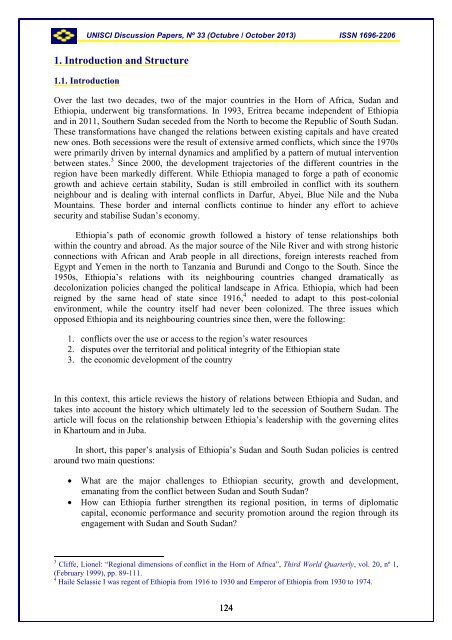UNISCI - Universidad Complutense de Madrid
UNISCI - Universidad Complutense de Madrid
UNISCI - Universidad Complutense de Madrid
You also want an ePaper? Increase the reach of your titles
YUMPU automatically turns print PDFs into web optimized ePapers that Google loves.
<strong>UNISCI</strong> Discussion Papers, Nº 33 (Octubre / October 2013) ISSN 1696-22061. Introduction and Structure1.1. IntroductionOver the last two <strong>de</strong>ca<strong>de</strong>s, two of the major countries in the Horn of Africa, Sudan andEthiopia, un<strong>de</strong>rwent big transformations. In 1993, Eritrea became in<strong>de</strong>pen<strong>de</strong>nt of Ethiopiaand in 2011, Southern Sudan sece<strong>de</strong>d from the North to become the Republic of South Sudan.These transformations have changed the relations between existing capitals and have creatednew ones. Both secessions were the result of extensive armed conflicts, which since the 1970swere primarily driven by internal dynamics and amplified by a pattern of mutual interventionbetween states. 3 Since 2000, the <strong>de</strong>velopment trajectories of the different countries in theregion have been markedly different. While Ethiopia managed to forge a path of economicgrowth and achieve certain stability, Sudan is still embroiled in conflict with its southernneighbour and is <strong>de</strong>aling with internal conflicts in Darfur, Abyei, Blue Nile and the NubaMountains. These bor<strong>de</strong>r and internal conflicts continue to hin<strong>de</strong>r any effort to achievesecurity and stabilise Sudan’s economy.Ethiopia’s path of economic growth followed a history of tense relationships bothwithin the country and abroad. As the major source of the Nile River and with strong historicconnections with African and Arab people in all directions, foreign interests reached fromEgypt and Yemen in the north to Tanzania and Burundi and Congo to the South. Since the1950s, Ethiopia’s relations with its neighbouring countries changed dramatically as<strong>de</strong>colonization policies changed the political landscape in Africa. Ethiopia, which had beenreigned by the same head of state since 1916, 4 nee<strong>de</strong>d to adapt to this post-colonialenvironment, while the country itself had never been colonized. The three issues whichopposed Ethiopia and its neighbouring countries since then, were the following:1. conflicts over the use or access to the region’s water resources2. disputes over the territorial and political integrity of the Ethiopian state3. the economic <strong>de</strong>velopment of the countryIn this context, this article reviews the history of relations between Ethiopia and Sudan, andtakes into account the history which ultimately led to the secession of Southern Sudan. Thearticle will focus on the relationship between Ethiopia’s lea<strong>de</strong>rship with the governing elitesin Khartoum and in Juba.In short, this paper’s analysis of Ethiopia’s Sudan and South Sudan policies is centredaround two main questions:• What are the major challenges to Ethiopian security, growth and <strong>de</strong>velopment,emanating from the conflict between Sudan and South Sudan?• How can Ethiopia further strengthen its regional position, in terms of diplomaticcapital, economic performance and security promotion around the region through itsengagement with Sudan and South Sudan?3 Cliffe, Lionel: “Regional dimensions of conflict in the Horn of Africa”, Third World Quarterly, vol. 20, nº 1,(February 1999), pp. 89-111.4 Haile Selassie I was regent of Ethiopia from 1916 to 1930 and Emperor of Ethiopia from 1930 to 1974.124
















